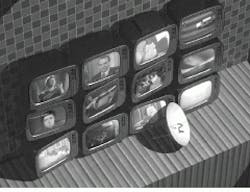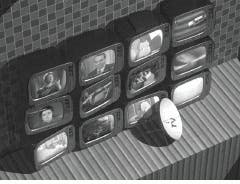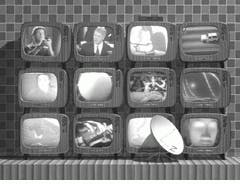Software tools generate holograms
ALAN RHODY
Optical- and digital-based imaging systems are merging in the holography studio to produce visual displays that cannot be reproduced by either technology alone. Holographers are now able to use digital hardware and software tools along with laser-based recording systems to create fully dimensional animated images that previously could not be produced in any practical way. Conversely, computer-graphics artists are utilizing newly developed hologram printers as a unique output device for their work. This hybrid technology is resulting in further applications for lasers, computers, and visual-display technologies.
Computer-graphics artists can now use accessible hardware and software to generate camera-ready artwork that holographers can assemble into holographic images displaying dimension, depth, projection, and motion. Many holographers are substituting such digitally originated artwork in place of the time-consuming drawings and hard-to-record physical objects that can require expensive cinematic photographic sessions. Computers increase flexibility and versatility in the design and production processes, as well as cut production costs.
The process can be broken into three parts. First, the digital artwork is output as a series of graphics files that must be sent to a holographic production studio. Then the holographer uses these files to generate a master hologram that is recorded on a high-resolution photographic emulsion using a continuous-wave laser. Traditionally, HeNe lasers have been used to record holograms onto red-sensitive emulsions. To meet commercial demands, however, professional production facilities frequently use argon-ion lasers to expose green-sensitive film emulsions and HeCd lasers to record onto photo resist materials. Color holograms are made with three lasers or one tuned to three different wavelengths. A less expensive color option is to physically expand or swell the film emulsion and change the incident beam angles, which changes the interference patterns during light refraction, for a color effect.
The resulting hologram is a new kind of hardcopy capable of displaying fully dimensional and animated images. The master hologram is then replicated by various means depending on the application. Typically the hologram is mass replicated mechanically by embossing it onto a thin foil, or optically by copying onto photo polymer film--techniques suitable for commercial applications. In the near future, desktop "holo-copiers" might connect to any graphics workstation and produce finished holograms as easily as conventional printers make pages.
Image projection and depth
Digital tools have been integrated into the origination process for three catagories of holograms—two-dimensional (2-D)/three-dimensional (3-D), 3-D, and animated stereograms. One of the most frequently produced holograms is the 2-D/3-D, an array of flat 2-D graphics, usually drawings or photos, that are stacked together with a small amount of 3-D space between each layer. In the finished hologram, the main image is usually positioned on the hologram surface, the background image appears behind the surface, and a foreground element "floats" in mid-air slightly above it.
These layers of artwork can be easily generated using familiar software tools. Adobe Illustrator and MacroMedia Freehand can be used to create drawings. Adobe Photoshop allows importing existing artwork and makes it suitable for holographic reproduction. Font collections are often utilized to create logos.
Once the artwork is finished, the digital files are sent to the production studio where a designer will typically use Adobe Separator, Quark Express, or Photoshop to break the image into its component layers. These files will be sent to an imagesetter, a film output device that generates transparencies corresponding to the different levels of the image. The holographer then records the graphics from these transparencies onto a single hologram to produce a multilevel image.
3-D holograms: parallax and dimension
Another type of hologram utilizes 3-D physical objects as the subject matter to be recorded. Many commercial holographers often commission professional modelmakers to sculpt highly detailed miniatures because these can be recorded in conventional holographic setups more easily than a full-size object. When the finished hologram is properly displayed, a viewer will see an apparently solid image that duplicates the original subject matter—as in real life, the viewer can look around all the sides of a holographic image. This effect is true parallax and no stereoscopic devices or other visual tricks are needed to perceive proper perspective or image depth.
Software can be used to generate artwork that can replace the physical models or objects used in the 3-D-holography process. Here the computer-graphics artist first models a real or an imaginary object or scene on screen. NewTek Lightwave3D, Byte by Byte Sculpt 4D, or Alias/Wavefront Power Animator are some modeling programs that can be used. The computer then is used to render an appropriate sequence of graphics files that correspond to the various visual perspectives that the designer wants to appear in the finished hologram (see figure). For rendering simple rotations, Pentium-based PCs or PowerMacs can be used. More complex imagery involving hundreds of different perspectives of one image needs support such as the DeskStation Technology Raptor rendering engine or Silicon Graphics Indigo hardware.Animated images
The techniques discussed showcase holographic dimensional properties. It is also possible to record time and motion on a hologram because a single hologram can hold hundreds of different images. If an appropriate time sequence of images is recorded, a viewer moving past this holographic stereogram will see each image displayed sequentially. This holographic mini-movie can replay up to 10 seconds of animation using current technology.
The animated images can be originated from any source that can be digitized, including video, film, slides, computer graphics, or CD-ROM images. As in generating static 3D images, the computer is used to render a appropriate set of files which are input into the holographic printer. A fully dimensional, animated image is recorded onto holographic film that can be mass replicated in a suitable manner.
Alan Rhody reports about holograms and the holographic industry for Ross Books, POB 4340, Berkeley, CA 94704; email: [email protected].


